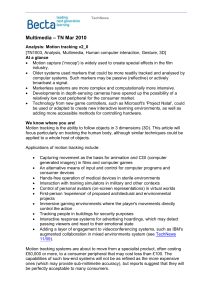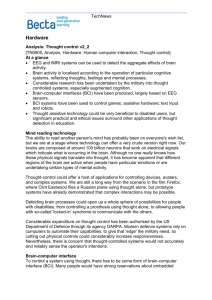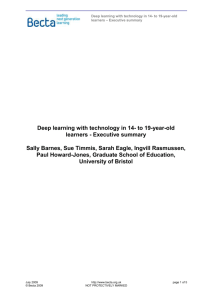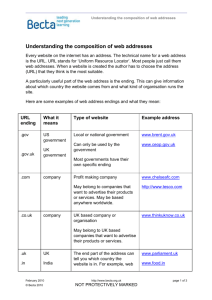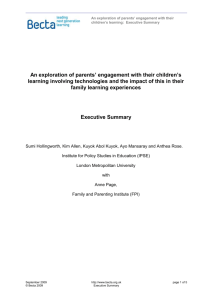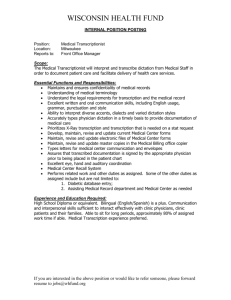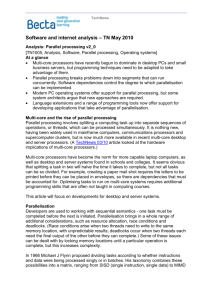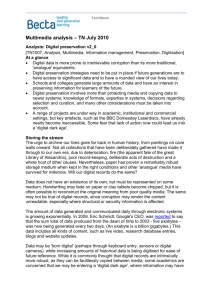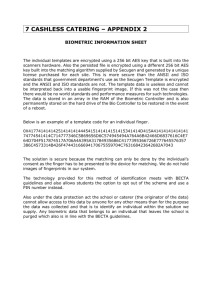TN 0909 SW - Speech recognition v2_1
advertisement
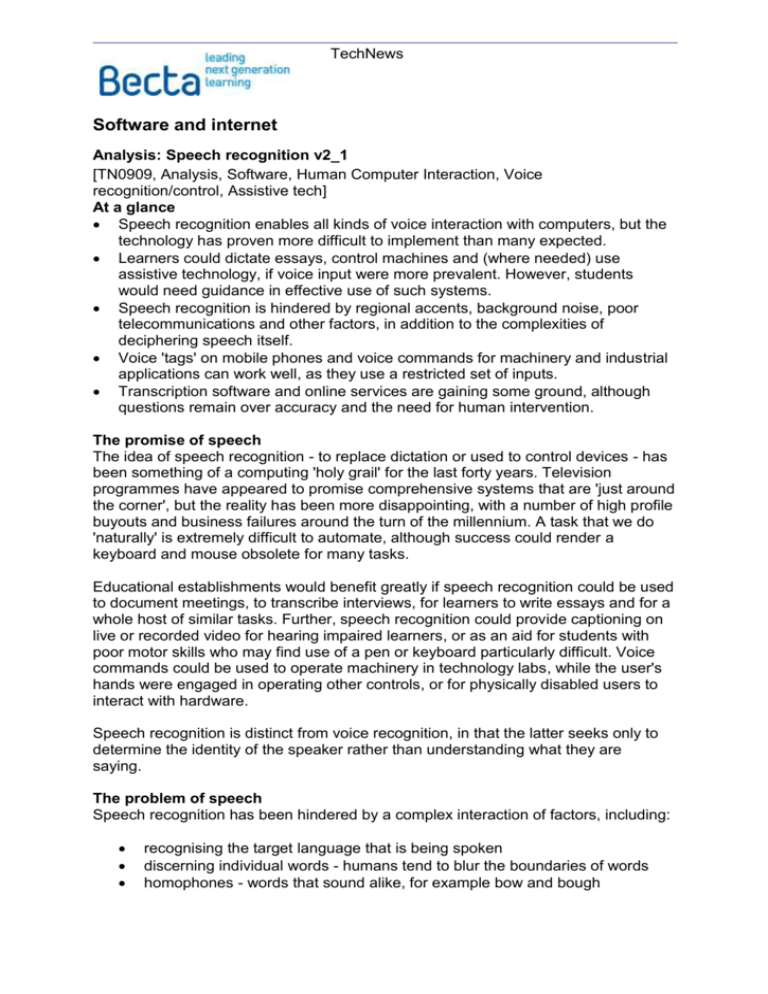
TechNews Software and internet Analysis: Speech recognition v2_1 [TN0909, Analysis, Software, Human Computer Interaction, Voice recognition/control, Assistive tech] At a glance Speech recognition enables all kinds of voice interaction with computers, but the technology has proven more difficult to implement than many expected. Learners could dictate essays, control machines and (where needed) use assistive technology, if voice input were more prevalent. However, students would need guidance in effective use of such systems. Speech recognition is hindered by regional accents, background noise, poor telecommunications and other factors, in addition to the complexities of deciphering speech itself. Voice 'tags' on mobile phones and voice commands for machinery and industrial applications can work well, as they use a restricted set of inputs. Transcription software and online services are gaining some ground, although questions remain over accuracy and the need for human intervention. The promise of speech The idea of speech recognition - to replace dictation or used to control devices - has been something of a computing 'holy grail' for the last forty years. Television programmes have appeared to promise comprehensive systems that are 'just around the corner', but the reality has been more disappointing, with a number of high profile buyouts and business failures around the turn of the millennium. A task that we do 'naturally' is extremely difficult to automate, although success could render a keyboard and mouse obsolete for many tasks. Educational establishments would benefit greatly if speech recognition could be used to document meetings, to transcribe interviews, for learners to write essays and for a whole host of similar tasks. Further, speech recognition could provide captioning on live or recorded video for hearing impaired learners, or as an aid for students with poor motor skills who may find use of a pen or keyboard particularly difficult. Voice commands could be used to operate machinery in technology labs, while the user's hands were engaged in operating other controls, or for physically disabled users to interact with hardware. Speech recognition is distinct from voice recognition, in that the latter seeks only to determine the identity of the speaker rather than understanding what they are saying. The problem of speech Speech recognition has been hindered by a complex interaction of factors, including: recognising the target language that is being spoken discerning individual words - humans tend to blur the boundaries of words homophones - words that sound alike, for example bow and bough Becta | TechNews the problem of context, in which the meaning of words can change (such as 'wicked') and the introduction of new or specialist vocabulary regional accents and dialects minor speech impediments, such as stuttering, mispronunciation of particular consonants or undue sibilance inconsistency in speech, brought on by emotion, stress, tiredness or illness background noise microphone quality connection or call quality when mediated by telecommunications processor power and software capability. One problem is rarely addressed: we tend to think in different ways when we speak compared to when we write. Imagine a verbatim record of a meeting, even without all the 'huhs' and 'errs', it would create a very unhelpful set of minutes. Likewise, creating an essay tends to involve significant pauses while structuring arguments or searching for the correct phrase - these can all be picked up by a dictation system as we 'think out loud' and the software will then try to interpret them according to its speech model. Speech applications Voice commands work well in restricted circumstances, as a limited vocabulary is required. Contacts lists can be accessed using 'voice tags' on mobile phones and some control or navigation systems will respond to specific commands. In the case of the former, the software only has to compare the spoken 'tag' against prerecorded samples of the user's own voice, while in the latter a small set of commands is chosen to be relatively distinct and unambiguous. Ford Synch 3.0 (covered in this TechRadar article) uses voice commands to interact (via a Bluetooth connected phone) with navigation and other data stored on remote servers. The CEO of Sensory Inc was recently commented on a future where speech-controlled Internet devices (SCIDs) would be prevalent, such as alarm clocks that could be commanded to give you a weather report. Direct voice input (DVI) is used to interact with military avionics systems, for example Qinetiq's Vocs application, as part of a voice user interface (VUI). Computing has a report on the use of a system from Voiteq that uses speech for warehouse management, ensuring that items are correctly stored and picked without operators in a dusty environment having to physically interact with terminals. IBM and Nuance recently agreed to collaborate on implementing voice systems across a wide range of industries. Call centres often use basic speech recognition as part of their computer telephony integration (CTI) systems, which process calls, allocate operators and record outcomes from conversations. However, automated voice systems have met with mixed success and have revealed the danger of aggravating a frustrated user before they are routed to a human assistant. A number of companies are developing speech systems that interact with the content of phone calls, or which combine voice control with web applications. Among these are Ditech Networks, who offer in-call monitoring for key words that bring up © Becta 2009 http://emergingtechnologies.becta.org.uk Month Year page 2 of 4 Becta | TechNews menus to (for example) search for a pizza outlet or create calendar entries, and Ribbit (now owned by BT), who offer a variety of application programming interfaces (APIs) that interact with Flash and other web programming technologies. These applications have great potential, but raise both privacy concerns and the issue of call quality interfering with accuracy. Google and Yahoo are among companies that offer search applications powered by voice commands that interact with a remote search engine to provide results on a user's mobile phone. These services can make it easier to input searches, as users do not have to type using fiddly numeric keypads, as well as safer for drivers who want to access information in a 'hands-free' mode. Once the search term has been spoken, it is processed remotely and the results are returned as a standard search listing. However, BBC technology correspondent Rory Cellan-Jones found back in November 2008 that Google's system had a distinct bias to US pronunciations, although a Google spokesperson told the BBC in April this year that these problems had been largely resolved. A Guardian video report features a Microsoft system that is being developed which searches speech to index video streams. The context is a home media centre operated by a standard remote control pad, which is used to find a specific video and jump to the correct location where the search term is being discussed. The main speech processing is almost certainly carried out in a remote data centre. Speech recognition and transcription Dictation and speech transcription have been subject to intense research, with a recent desire to transcribe voicemail to forward as email or SMS adding impetus. Following reorganisations and takeovers early this decade, Nuance's Dragon NaturallySpeaking and Windows Speech Recognition in Windows Vista and Windows 7 are two of the main systems available to consumers. (Nuance suggests that Dragon users can achieve 'up to 99%' accuracy while dictating as fast as 120 words per minute.) Earlier versions relied on 'discrete speech', where users had to leave gaps between words so that the software could correctly identify them; modern systems can interpret 'continuous speech' with no gaps. Speech recognition is a subset of natural language processing (NLP). This uses sophisticated statistical models to identify speech segments and compare these to dictionaries of phonemes (distinct units of sound), which are then built up into words to be matched to language-specific and specialist application dictionaries. Recognition is generally improved through 'training', whereby users record sections of prose and make corrections to the program's output, so that the software can define a set of mathematical transformations used to 'deform' the standard speech model to the user's actual voice. Online services, such as SpinVox and VoxSciences, aim to transcribe voicemail messages as either emails or texts, to make it easier for mobile users to keep in touch. Jott seeks to transcribe dictated voice memos and new VoIP services, such as Google Voice, also advertise voicemail transcription. (See TechNews 03/09 for details of Voice over IP.) © Becta 2009 http://emergingtechnologies.becta.org.uk Month Year page 3 of 4 Becta | TechNews SpinVox was involved recently in public debate with the BBC concerning the level of human intervention compared to machine transcription involved in its service. The company has not revealed details that it considers commercially sensitive, but the exchange exposes the particular difficulties of transcribing fragmentary messages, which lack context and are sent over 'noisy' telecommunications links. A voice future? Speech recognition remains a niche application to most users, even though they may encounter it regularly in call centre systems, but for a small group of users it could be a significant enabling technology. Despite huge increases in processor power since the late 1990s, the issues outlined at the start of this article remain far from immaterial, such that effective use tends to rely on personalisation through creating voice tags or 'training' the software. Moving processing into the 'cloud' centralises capacity and can aggregate 'machine expertise', suggesting that much more effective systems will be available before long, although that may remain another unfulfilled promise for several years. Speech transcription is unlikely to see widespread use in education over the short to medium term; the few using the current generation of relatively expensive, complex, specialist software will require access to powerful, personally-owned devices. If it became more common, learners would need coaching in the thinking skills required to use such systems effectively. However, learners with disabilities have found some of these systems very helpful, while specific speech input for controlling hardware or for inputting search terms on mobile devices are emerging as real alternatives. © Becta 2009 http://emergingtechnologies.becta.org.uk Month Year page 4 of 4
